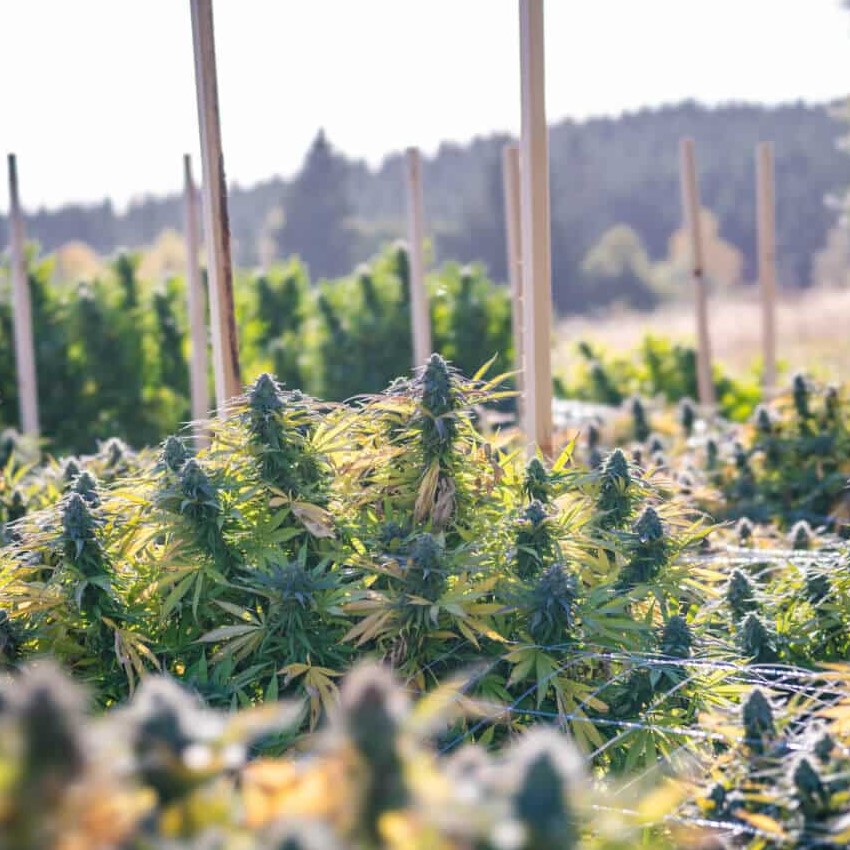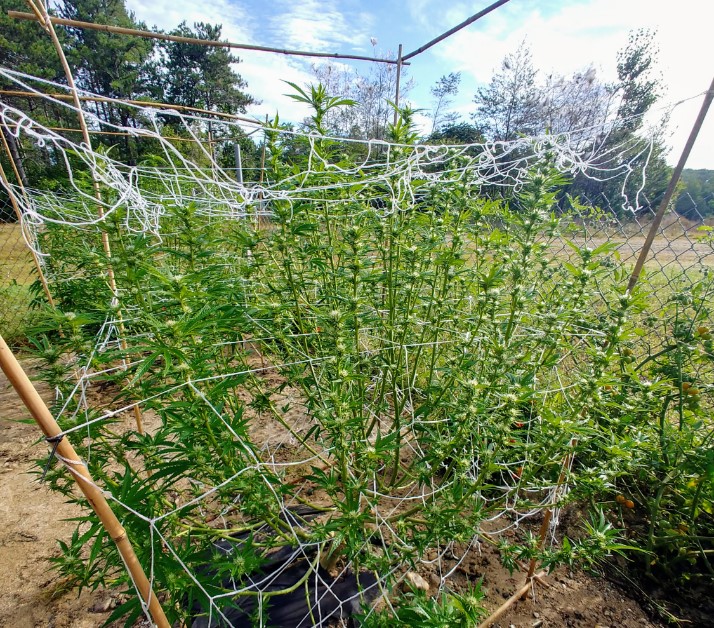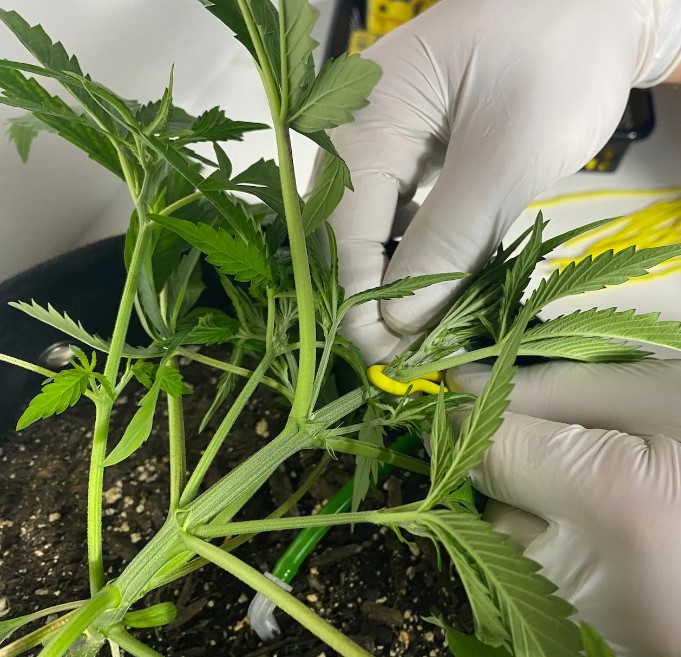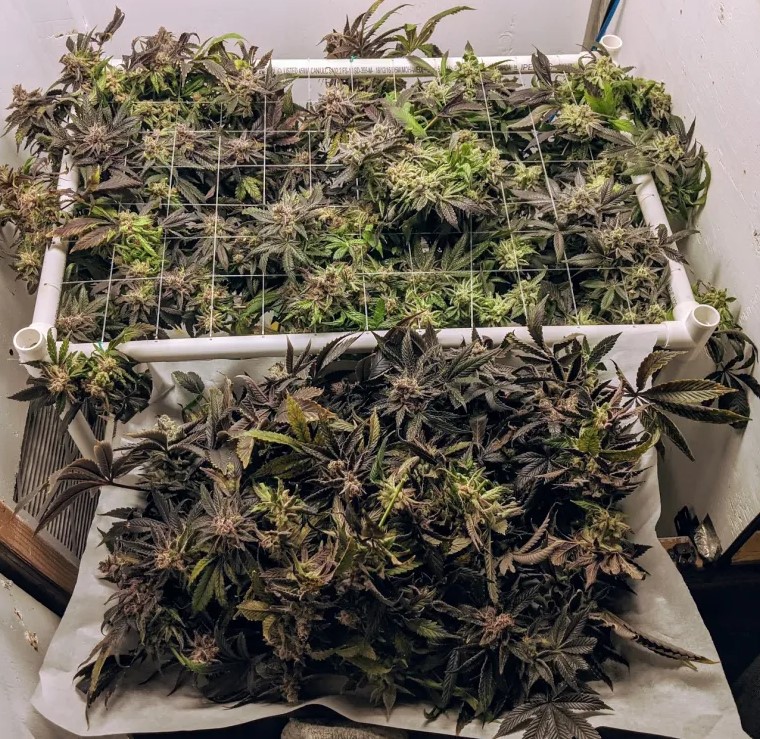Trellising cannabis is crucial for optimizing growth and maximizing yields. Learning how to trellis cannabis effectively helps support your plants, improve light exposure, and enhance air circulation, leading to healthier plants and a more bountiful harvest. This article covers essential techniques, materials, and tips to ensure successful cannabis cultivation.
Table of Contents
- Introduction to How to Trellis Cannabis
- Why Trellis Cannabis?
- Benefits of Trellising
- Choosing the Right Trellising Method
- Single-Plane Trellising
- Scrog (Screen of Green) Technique
- LST (Low-Stress Training)
- Using Tomato Cages and Stakes
- Essential Trellising Materials
- Types of Trellis Netting
- Wire and String
- Support Poles and Stakes
- Clips and Fasteners
- Setting Up Your Trellis System
- Planning and Design
- Installing Trellis Netting
- Securing Plants and Adjusting Growth
- Maintenance and Care
- Monitoring Plant Growth
- Adjusting Trellis as Plants Grow
- Troubleshooting Common Issues
- Harvesting and Beyond
- Removing Trellis for Harvest
- Post-Harvest Plant Care
- Preparing for Future Grows
- Tips and Tricks for Successful Trellising
- Common Mistakes to Avoid
- Advanced Techniques for Maximizing Yield
Introduction to How to Trellis Cannabis
Why Trellis Cannabis?
Trellising cannabis is a technique used to support and train plants as they grow, offering several advantages that can significantly enhance your cultivation process. By implementing a trellis system, you can control plant growth, improve light penetration, and ensure that each plant receives the optimal conditions for development. Trellising helps manage the plant’s height, which is particularly useful in confined grow spaces or when dealing with strains that have a tendency to stretch. Additionally, it assists in keeping plants off the ground, reducing the risk of disease and pests that can affect lower parts of the plant.
Benefits of Trellising
The benefits of trellising cannabis are manifold and contribute to both the health of the plants and the efficiency of the grow operation:
- Increased Yields: By supporting the plant’s branches and allowing them to grow more horizontally, trellising can enhance light exposure to all parts of the plant, leading to more even bud development and increased overall yields.
- Improved Air Circulation: Proper trellising creates more space between the plant’s foliage, promoting better air flow. This reduces humidity around the plant and lowers the risk of mold and mildew.
- Enhanced Light Distribution: Trellising allows for better light penetration, ensuring that lower branches receive adequate light, which can lead to more uniform growth and higher quality buds.
- Reduced Plant Stress: With a well-designed trellis, plants are better supported, which helps prevent branch breakage and reduces stress, particularly during the flowering phase when buds become heavier.
- Easier Maintenance: Trellised plants are more accessible for pruning, feeding, and monitoring. This accessibility simplifies maintenance tasks and allows for more efficient care.
Overall, trellising is a strategic practice that supports healthy plant development and maximizes the potential of your cannabis grow.
Choosing the Right Method to Trellis Cannabis
Single-Plane Trellising
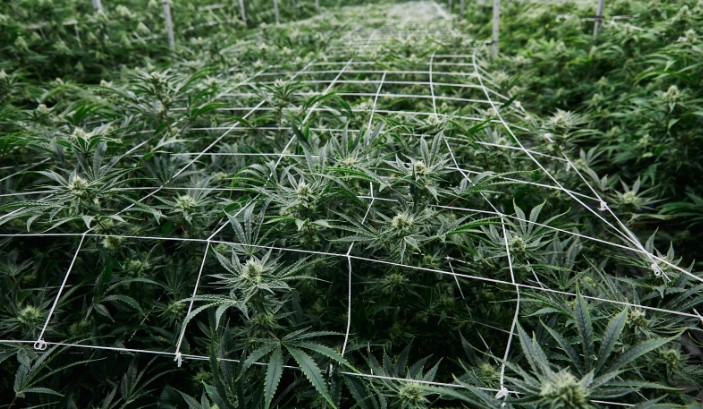
Single-plane trellising involves using a flat grid or net placed above the plants to guide their growth. This method is straightforward and effective for controlling the vertical and horizontal spread of the plant. It works well for managing plant height and promoting an even canopy, which improves light distribution and air flow. Single-plane systems are often used in smaller grow spaces or for crops that require less intensive training.
Scrog (Screen of Green) Technique
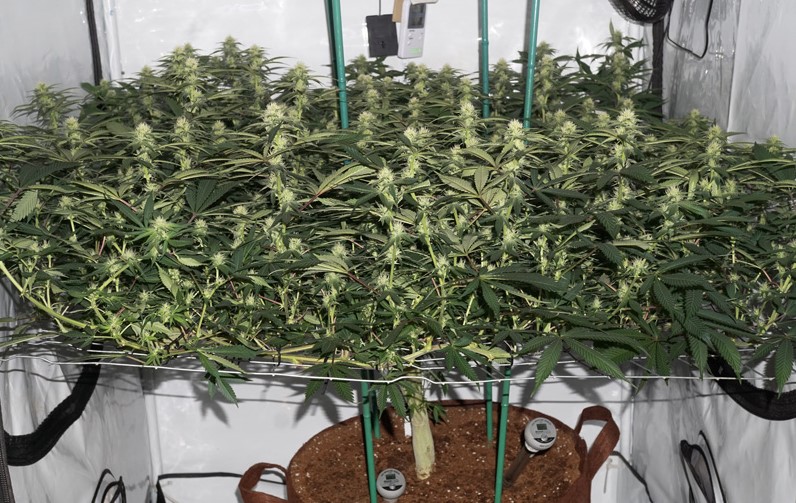
The Scrog method involves placing a screen or mesh above the plants and training their branches to grow through it. This technique encourages a more even distribution of growth and helps maximize light exposure to all parts of the plant. Scrog is particularly beneficial for maximizing yields in limited spaces and for strains that exhibit vigorous vertical growth. The screen helps to maintain a flat canopy, ensuring that each bud site receives optimal light.
LST (Low-Stress Training)
Low-Stress Training (LST) is a technique where branches are gently bent and tied down to promote horizontal growth rather than vertical. This method helps create an even canopy and allows for better light penetration. LST is a flexible approach that can be adapted as plants grow, making it suitable for various strains and growing conditions. It is less invasive than other methods, reducing the risk of plant stress and damage.
Using Tomato Cages and Stakes
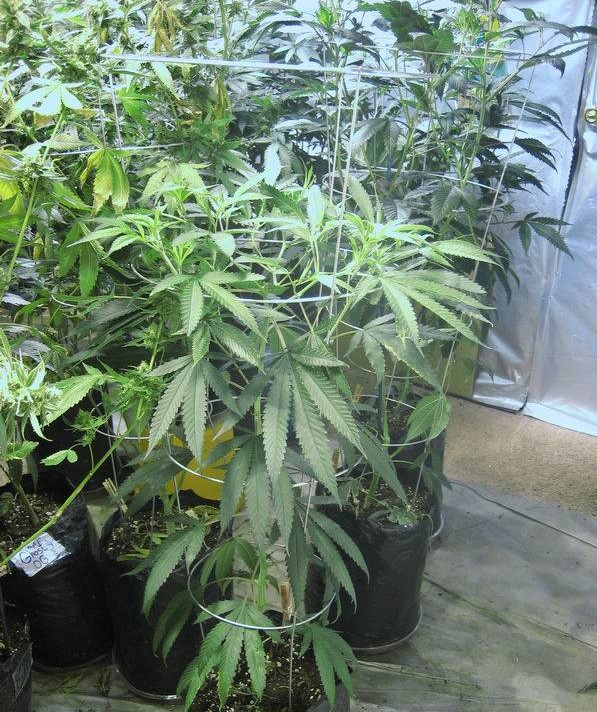
Tomato cages and stakes are simple, often pre-made solutions for supporting cannabis plants. Tomato cages offer a cylindrical support structure, ideal for smaller plants or those that require minimal training. Stakes provide individual support for each branch, allowing for targeted training and support. These methods are best suited for smaller grows or when a more straightforward support system is needed.
Selecting the right trellising method depends on your grow environment, plant strain, and cultivation goals. Each method offers distinct advantages, so consider your specific needs to determine the most effective approach for your cannabis garden.
Essential Tools to Trellis Cannabis
Types of Trellis Netting
Trellis netting comes in various types and materials, each suited for different needs and plant stages. Common options include:
- Plastic Mesh Netting: Durable and easy to clean, plastic mesh is often used for Scrog setups. It provides a stable structure for plants to grow through and supports even canopy development.
- Natural Fiber Netting: Made from materials like jute or cotton, natural fiber netting is biodegradable and environmentally friendly. It’s suitable for both indoor and outdoor grows, offering flexibility and strength.
- Metal Wire Netting: Metal wire netting is robust and long-lasting, ideal for heavy-duty support. It can withstand the weight of larger plants and is often used in larger grow setups or for perennial growing conditions.
Wire and String
Wire and string are versatile materials used for various trellising techniques, from LST to single-plane systems. They come in different gauges and types, including:
- Garden Wire: Available in plastic-coated or galvanized options, garden wire is strong and resistant to rust. It’s useful for creating custom trellis structures or securing plants in place.
- Twine or String: Cotton or synthetic twine is often used for tying plants to stakes or creating support systems. It’s flexible and easy to work with, making it suitable for low-stress training and branch support.
Support Poles and Stakes
Support poles and stakes provide essential support for individual plants or sections of a trellis system. Options include:
- Wooden Stakes: Classic and widely used, wooden stakes are sturdy and easy to install. They’re ideal for supporting plants during early growth stages or for basic trellising needs.
- Metal Stakes: Metal stakes, such as those made from steel or aluminum, offer greater durability and strength. They’re suitable for larger plants or more permanent installations.
- Adjustable Poles: Adjustable poles allow for flexibility in height and positioning, making them ideal for plants that require changing support as they grow.
Clips and Fasteners
Clips and fasteners are essential for securing plants to the trellis system and maintaining structure. Options include:
- Plant Clips: Often made of plastic or metal, plant clips attach branches to trellis netting or stakes. They’re adjustable and reusable, providing a secure hold without damaging the plant.
- Velcro Straps: Velcro straps are soft and adjustable, making them gentle on plant stems while providing reliable support. They’re particularly useful for LST and other training methods.
Choosing the right materials for your trellising system ensures that your plants receive the proper support and training for optimal growth. Consider your specific needs, plant size, and growing environment when selecting trellising materials.
Setting Up Your Trellis Cannabis System
Planning and Design
Before setting up your trellis system, careful planning is essential to ensure it meets your specific needs. Start by assessing your grow space and determining the ideal layout for your plants. Consider factors such as plant size, growth patterns, and the available space. Decide on the trellising method that best suits your goals—whether it’s a single-plane setup, Scrog system, or LST approach.
Sketch a design of your trellis system, taking into account the height and width of your plants and how the system will fit within your grow area. Make sure to account for easy access to the plants for maintenance tasks like pruning and feeding.
Installing Trellis Netting
Once you’ve planned your design, it’s time to install the trellis netting:
- Positioning: Determine the height at which you’ll place the netting based on your plants’ expected growth. Ensure it’s positioned to support the plants without crowding or restricting their growth.
- Securing the Netting: Attach the netting to support structures such as poles or walls. Use garden wire or sturdy ties to secure it in place, ensuring it is taut and evenly spaced.
- Adjustments: If using adjustable netting, make necessary adjustments to accommodate plant growth. Ensure that the netting is properly aligned to support branches and buds effectively.
Securing Plants and Adjusting Growth
With the trellis system in place, begin securing your plants:
- Training: Gently train your plant branches to grow through the trellis netting or along the support structures. For methods like Scrog, guide branches through the netting to create an even canopy. For LST, use soft ties to bend and secure branches in the desired positions.
- Securing: Use plant clips, Velcro straps, or garden wire to secure branches to the trellis. Ensure that the support is firm but not too tight to avoid damaging the plants.
- Monitoring: Regularly check your plants and trellis system to ensure that branches are adequately supported and that the trellis is not restricting growth. Make adjustments as needed to accommodate plant development and maintain an even canopy.
Setting up your trellis system with careful planning and attention to detail will provide your cannabis plants with the support they need for healthy growth and optimal yields. Regular monitoring and adjustments will help maintain an effective trellising system throughout the growth cycle.
Maintenance and Care
Monitoring Plant Growth
Once your trellis system is set up and your plants are secured, ongoing maintenance is key to ensuring optimal performance. Regularly monitor your plants to observe their growth and interaction with the trellis. Watch for the following:
- Branch Growth: Ensure branches are growing through or along the trellis as planned. Monitor for overcrowding, which can impede light distribution and airflow.
- Health: Check for any signs of disease or pests. Healthy plants will adapt well to the trellis system and show vigorous growth.
Pay close attention to how the plants are developing and make necessary adjustments to the trellis to support their growth effectively.
Adjusting Trellis as Plants Grow
As plants continue to grow, the trellis system may need adjustments to accommodate their changing needs:
- Height Adjustments: For adjustable trellis systems, modify the height of the netting or support poles to match the plants’ vertical growth.
- Repositioning: In methods like LST, periodically reposition ties and clips to ensure branches are properly supported and directed as desired.
- Expansion: If plants exceed the initial trellis setup, consider adding additional support or expanding the system to provide continued support.
These adjustments will help prevent issues such as branch breakage and overcrowding, ensuring that the trellis remains effective throughout the growth cycle.
Troubleshooting Common Issues
Even with careful setup, you may encounter some issues with your trellis system. Here’s how to address common problems:
- Overcrowding: Dense plant growth can lead to poor air circulation and increased risk of bud rot. To alleviate overcrowding, trim excess foliage and adjust the trellis to provide more space between branches. This will improve airflow and reduce the chance of mold or mildew forming in tightly packed buds.
- Bud Rot: If buds are too close together without sufficient airflow, they may be susceptible to bud rot. Regularly inspect buds and adjust the trellis to ensure adequate spacing and air circulation. Removing affected buds promptly can help prevent the spread of rot.
- Broken Branches: If branches break due to insufficient support, reinforce the area with additional ties or clips and make adjustments to the trellis to prevent future damage.
- Light Blockage: Ensure that the trellis does not obstruct light from reaching lower branches. Modify the trellis setup if necessary to improve light penetration and distribution.
By addressing these issues promptly, you can maintain a healthy and effective trellis system, supporting your plants and contributing to a successful and bountiful harvest. Regular monitoring, adjustments, and proactive care are essential for optimal results.
Harvesting and Beyond
Removing Trellis for Harvest
As your cannabis plants reach maturity and it’s time to harvest, you’ll need to carefully remove the trellis system to avoid damaging the buds:
- Prepare for Harvest: Before removing the trellis, ensure you have all necessary tools and space prepared for the harvest process. Gather pruning shears, gloves, and containers for collected buds.
- Detach the Trellis: Carefully unfasten or cut any ties, clips, or netting securing the plants. If using a net or screen, gently lift it away from the plants, being mindful of the delicate buds and branches.
- Support During Removal: If your plants are heavily laden with buds, you may need to provide additional support to avoid breakage while removing the trellis. Have someone assist if necessary, or use supports like stakes to stabilize the branches.
Post-Harvest Plant Care
After removing the trellis and harvesting your plants, attend to post-harvest care to ensure proper processing and preparation for future grows:
- Trim and Clean: Trim excess leaves and any remaining plant material from the buds. Proper trimming enhances the quality and appearance of the final product. Clean your workspace and equipment thoroughly to prevent contamination.
- Drying and Curing: Hang the trimmed buds in a controlled environment with proper airflow and humidity levels to dry. Once dry, cure the buds in airtight containers, periodically opening them to release moisture and improve flavor and potency.
- Inspect for Issues: While processing your buds, inspect them for any signs of mold, rot, or other issues that may have developed during growth. Address any problems promptly to ensure a high-quality final product.
Preparing for Future Grows
With your current harvest completed, it’s time to prepare for the next grow cycle:
- Clean and Sanitize: Clean and sanitize your trellis system and grow area thoroughly to prevent the spread of pests and diseases. Check for any damage to your trellis materials and repair or replace as needed.
- Evaluate and Plan: Review the effectiveness of your trellising setup and make notes on what worked well and what could be improved. Adjust your plans for future grows based on your observations and experience.
- Replenish Supplies: Restock any trellising materials or tools that may have been worn out or used during the previous grow. Ensure you have everything you need for a successful next cycle.
By following these steps, you’ll ensure a smooth transition from one grow cycle to the next, maintaining a healthy and productive cultivation environment. Proper post-harvest care and preparation for future grows are essential for continued success in cannabis cultivation.
Tips and Tricks on How to Trellis Cannabis
Common Mistakes to Avoid
Effective trellising requires attention to detail and a good understanding of your plants’ needs. Avoid these common mistakes to ensure a successful setup:
- Inadequate Support: Failing to provide sufficient support can lead to branch breakage and reduced yields. Ensure your trellis system is strong enough to handle the weight of your plants, especially during the flowering stage when buds become heavier.
- Poor Planning: Skipping the planning phase can result in a poorly designed trellis system that doesn’t fit your grow space or meet your plants’ needs. Take the time to plan your setup carefully, considering plant size, growth patterns, and available space.
- Ignoring Plant Growth: Neglecting to adjust the trellis as plants grow can lead to overcrowding and inadequate light distribution. Regularly monitor plant growth and make adjustments to the trellis system to accommodate changes and maintain an even canopy.
- Overcrowding: Allowing plants to grow too densely can restrict airflow and light penetration, increasing the risk of mold, mildew, and poor bud development. Ensure proper spacing between branches and adjust the trellis to provide adequate room for growth.
Advanced Techniques for Maximizing Yield
To further enhance your trellising efforts and boost your yields, consider these advanced techniques:
- Topping and Fimming: Topping (cutting off the top of the plant) and fimming (partial cutting of the top) can promote bushier growth and more bud sites. Combine these techniques with your trellis system to create a more even canopy and increase overall yield.
- Supercropping: This technique involves gently crushing the stems to create bends and increase branching. Use supercropping in conjunction with trellising to manage plant height and improve light distribution.
- SOG (Sea of Green): The SOG method involves growing multiple smaller plants in close proximity to create a dense canopy. Pair this technique with a trellis system to support the increased number of plants and maximize light exposure.
- Defoliation: Selectively removing leaves to improve light penetration and airflow can enhance bud development. Use defoliation strategically in combination with trellising to maintain plant health and optimize yields.
Best Practices on How to Trellis Cannabis
To get the most out of your trellising system, adhere to these best practices:
- Regular Maintenance: Conduct regular checks and adjustments to ensure that your trellis system remains effective throughout the growth cycle. Address any issues promptly to maintain plant health and support.
- Environmental Control: Manage environmental factors such as humidity, temperature, and light to create optimal growing conditions. Proper environmental control complements a well-designed trellis system and enhances overall plant health.
- Documentation: Keep detailed records of your trellising setup, adjustments, and plant responses. This information will be valuable for refining your techniques and improving results in future grows.
By avoiding common mistakes, incorporating advanced techniques, and following best practices, you can maximize the effectiveness of your trellising system and achieve a more successful and productive cannabis grow.

